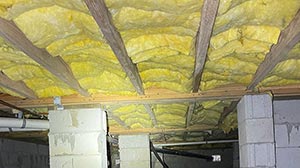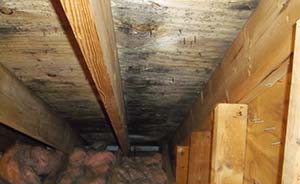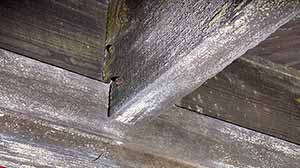Crawl spaces are usually located around the home’s foundation. Contractors cover the ground with a plastic layer to reduce moisture. If your home’s crawl space gets flooded due to flooding or a broken pipe, you need to act quickly to remove the water.
Remove the water immediately if your crawl space is flooded to prevent permanent damage. Use a sump pump to remove the water from your crawl space and air out the area to avoid mold. Install a drainage system so water will no longer collect in your crawl space.
Water beneath the ground can come from a broken pipe or the underground water table. Water above the ground can come from rainwater or leaking pipes.
The process of recovering a flooded crawl space may be complex and dangerous. If there is damage, an expert can evaluate it, remove the water, dry and dehumidify it, and treat it to kill mold.
If the floodwater isn’t dried fast, it can harm the building, increase the energy bill, and cause health issues.
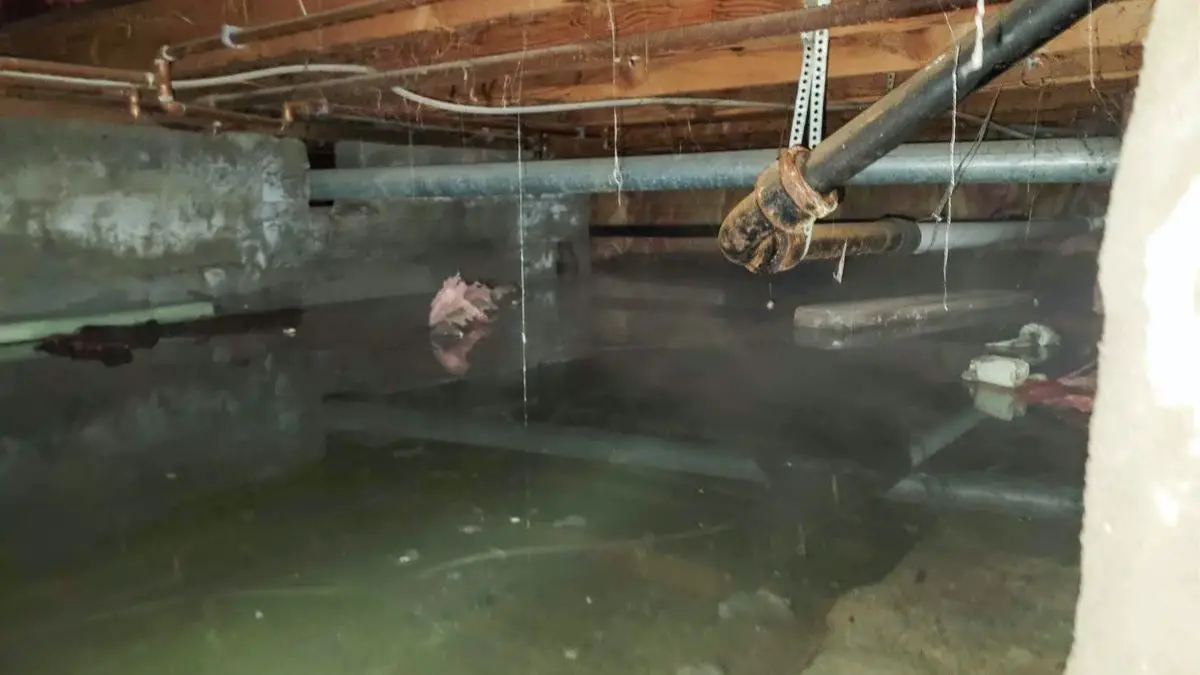
How to Remove Water From Flooded Crawl Space
Remove the water quickly if your crawl space floods to prevent damage and mold growth. Below are steps to take to get rid of the water and recover the space:
1. Stop the Water
First, identify the source of water and stop it if you can. You can usually close the main tap if it’s a burst pipe.
If water is coming from flooding, leaky pipes, or sewage backups, you may not be able to stop it because it can be strong and in large amounts.
2. Assess the Level of Loss and Damage
After stopping the water flow, take stock of the damage and loss caused by the excess water. You may need to hire a professional to assess the level of damage and the loss suffered. There are risks when dealing with a flooded part of the house, like an electric shock from exposed power cables.
The contractor will assess the situation first. They will then recommend what to do to prevent more damage.
3. Drain All the Excess Water
After doing the loss assessment, the next step is to drain the water out. This process may require an expert with specialized skills and equipment.
Experts often use fans, dehumidifiers, wood floor dryers, and extractors to clear the air. They also use sub-floor dryers and high-quality blowers.
4. Clear Damaged Items and Building Materials
After draining all the water, it is time to remove any items that need replacement. Eliminating these items creates space for air circulation and quick drying. Things you may have to remove include insulation, carpet, and drywall.
5. Drying and Dehumidifying
After the excess water drains, it is time to dry any remaining water. Experts use methods like dehumidification to dry the house, reduce humidity, and prevent the spread of mold. You can use structural drying dehumidifiers and high-volume fans to dry much faster.
Dehumidifiers lower moisture levels to dry crawl spaces. They can quickly remove crawl space humidity, drying puddles of water on the vapor barrier.
6. Cleaning and Sanitization
Usually, the floodwater carries all types of dirt and debris along its way. After draining the excess water, removing the dampness, and allowing it to dry, it is time to clean and sanitize the place. Cleaning and sanitizing can help to get rid of visible dirt and debris.
7. Mold Treatment
Mold treatment is one of the processes that may force you to use an expert instead of doing it yourself. Flooding usually creates damp conditions that lead to the growth of molds. Molds may cause health problems and lower the house’s resale value.
Water In Crawl Space
Water in confined areas can lead to mold, rotting wood, and damage to structures. To avoid these problems, address the water source and use drainage systems or vapor barriers. Homeowners can regularly inspect to find and fix water problems.
What Causes a Crawl Space to Flood?
Water can enter your crawl space from the ground, heavy rainfall, or broken plumbing, leading to flooding.
Drainage Issues
If you see frequent flooding, it could mean your drainage system has a bigger issue. Drainage problems include broken window wells, negative grading, and poor guttering.
Sump Pump
Water can enter the crawl space if your sump pump fails. KC Waterproofing says maintaining a sump pump is cheaper than replacing it and fixing damage from failure.
Cracked Foundations
If the basement or slab foundation is cracked, water can seep into the wall and cause excess moisture or flooding.
Broken And Leaking Pipes
When you have broken and leaking water lines, they can cause damp crawl spaces. Surface water can cause problems like poor structural integrity, wood rot, and mildew growth.
It is important to fix leaking water lines quickly; otherwise, you could have serious structural and health issues.
Sewage Backup
Your crawl space could flood if the sewage system overwhelms or the plumbing clogs. Besides damaging your foundation, a sewer backup can create an environment conducive to mold growth and other health hazards like bacteria.
How to Prevent Your Crawl Space from Flooding
Once you figure out what caused the flooding in your crawl space, the next thing to do is find a solution. Several minor problems may be simple and easy to handle yourself. If the problem is serious, you might need help from a professional to fix it.
1. Fix Your Drainage System
A broken or clogged drainage system affects wastewater flow around your home. Houses have downspouts and gutters. These help move rainwater and wastewater away from your home. If your house’s foundation soaks up water, it can cause flooding by drawing in more water from below.
The drainage system can become overwhelmed during heavy rain, allowing rainwater into the crawl space. This weakens the foundation, which can affect the strength of the structure. It can also make your family less safe and secure.
Three types of drainage systems can prevent flooding and fight a damp crawl space:
- French Drain – French drains redirect water away from a home’s foundation or affected areas. These are commonly placed in problem areas to remove excess water and reduce pressure. The perforated pipe allows water to flow away from the foundation. French drains can stop water from collecting in low-lying areas like the crawl space or basement.
- Full Gutter System – A complete gutter system removes extra water from flood-prone areas. It directs the water to ponds, collection systems, and stormwater management areas. The drainage system gathers water from the roof, protecting the house’s foundation. Instead of using a whole gutter system, you can add downspout extensions to guide water elsewhere.
- Sump Pump – A sump pump is a small pump in the crawlspace and basement to move water to specific places. Sump pumps help to prevent large-scale flooding in low-lying areas.
2. Assess and Fix Any Foundation Cracks
The crawl space could flood because of heavy rain, broken water lines, plumbing leaks, or a cracked foundation. As a result, the foundation becomes weaker, affecting the structure’s overall strength. Water can impact the foundation and strength of a building in three main ways.
- Hydrostatic Pressure – When water collects around the house, it creates hydrostatic pressure on the foundation and cracks the walls.
- Expansive soils – expansive soil usually contains minerals that absorb water. This water causes the foundation to crack. Additionally, when the expansive soil dries, it shrinks. The expansion and contraction of expansive soil exert pressure and weaken the building in the long run.
- Erosion – Erosion occurs when water washes soil around a foundation, causing it to settle. Foundation settlement causes uneven floors and sinking. Other signs include cracks in drywall, tilting chimneys, and faulty doors and windows.
Foundation cracks can cause extensive damage to the building and weaken its strength. Ensure proper water drainage to prevent water buildup that causes pressure and cracking. You can also do waterproofing to cover the yard and basement.
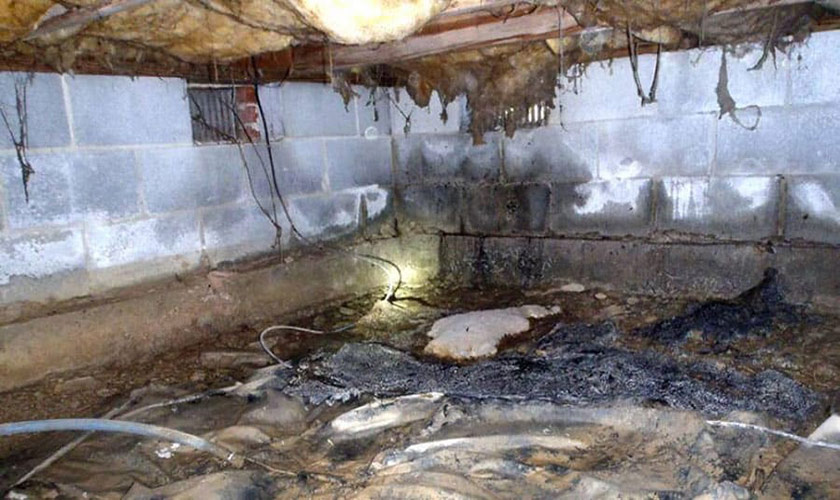
Water In Crawl Space After Heavy Rain
Water in crawl space after heavy rain is a common problem homeowners face. It occurs when rainwater seeps through the ground and accumulates in the crawl space. This can lead to various issues, such as mold growth, structural damage, and musty odors. Better drainage and waterproof basement walls to prevent more damage.
A sump pump is usually installed in crawlspaces to prevent flooding. It is designed with a basin and a pump that sucks water through the pipes directing it away from the house. You can install a sump pump if you live in an area that experiences frequent flooding.
Sump pumps come in two forms:
- Pedestal Pumps
- Submersible Pumps
Pedestal pumps are partly above the ground. Submersible pumps are completely under the ground.
The main factor in installing a sump pump is how much flooding occurs and how it affects the house’s stability. If your house is in a low-lying area, a sump pump could be a must due to vulnerability due to water damage.
Floodwater can harm your home in many ways, such as damaging appliances and causing wood rot. The greatest danger is always the damage to the building.
A sump pump improves air quality inside, keeps bugs out, protects appliances, and stabilizes the building.
Pump Water Out Of Crawl Space
To pump water out of a crawl space, homeowners can use a sump pump or a wet/dry vacuum. Someone puts a sump pump in a pit, and it takes out water. You manually use a wet/dry vacuum. It’s important to address the source of the water issue to prevent further damage and mold growth.
4. Fix Broken or Leaking Pipes
Your home relies on water lines to supply water to various sections. Your home water line can fail because it’s old, damaged, exposed to extreme temperatures, or poorly designed. If a pipe is broken or leaking, it can cause a lot of damage to the building. It can also make the energy bill go up.
5. Using Flood Vents
Flood vents are permanent wall openings between the crawl space and the outdoor. They are larger than traditional crawl space vents. They let any water out before it fills the crawl space and exerts pressure on the walls. You may require these vents, especially if your house is on a floodplain.
How To Drain Water From Under House
To remove water from under a house, first find where the water is coming from. Then, repair any leaks or problems with the foundation. Next, create a trench or drain system leading away from the house to redirect the water. Consider installing a sump pump or French drain for more effective drainage. To get the right solution, ask professionals for help and expert advice.
Problems Caused by a Wet Crawl Space
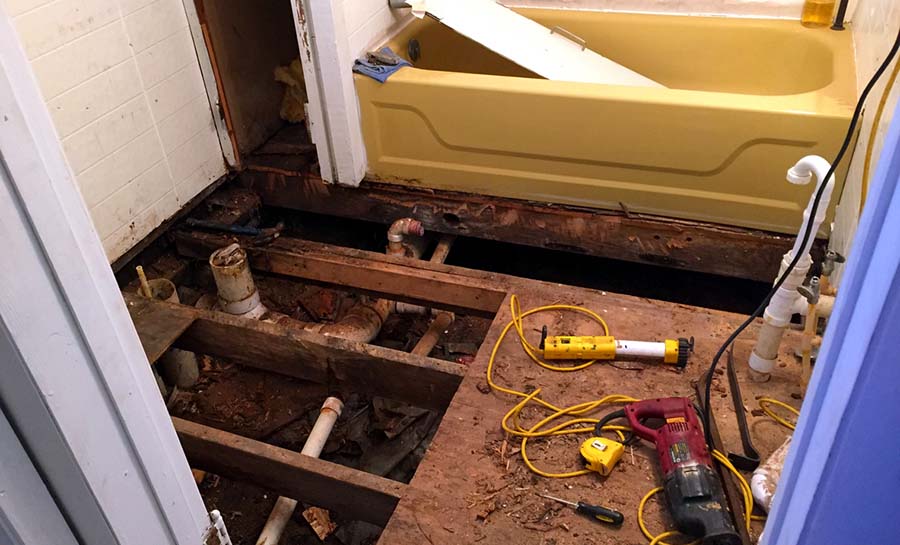
If you leave your crawl space in damp conditions for long, it may cause lasting effects. Below are problems caused by wet and flooded crawl space:
- High Energy Bills: a wet crawl space increases the humidity level within the entire house. Humid air is warmer and requires more energy to cool. High energy bills occur when you keep your AC on for a long time. In addition to using a dehumidifier, you can apply waterproofing to fix the problem permanently.
- Mold: damp places offer perfect conditions for the breeding and growth of mold. When mold accumulates in your crawl space, it circulates in the air. Inhaling mold causes health complications, irritation, and allergies.
- Pest Infestations: stagnant water in your crawl space can bring pests like cockroaches, ants, termites, and rodents.
- Damp, Musty Odors: stagnant water, mildew, mold, and rotting debris may cause a damp, musty odor to enter your living area. It also leads to poor air quality, which may cause health complications.
- Structural Damage: when the foundation of your house is submerged in water for long, it starts to weaken. Wooden substructures also become weak when they take in a lot of water. Structural damage may be the highest cost to bear as it compromises the stability and strength of the entire structure.
DIY vs. Hiring a Professional to Remove Water From Flooded Crawl Space
If your crawl space has a lot of flooding, you can fix it yourself or hire a professional. Taking water out of the flooded crawl space is difficult because of the danger of electric shock.
An expert can evaluate the damage and suggest the best ways to fix the place fast. Experts who handle crawl space flooding have the skills and tools to clear the water.
How Much Does It Cost to Fix a Flooded Crawl Space?
The price of removing water from your crawl space depends on a few things: size, location, and how flooded it is. The process may involve replacing and redirecting a gutter and fixing foundation cracks.
It costs between $1,200 and $4,500. This figure increases dramatically as the amount of water goes up. Some homeowners also install hygrometers to monitor your house’s humidity level.
Waterproofing Your Foundation To Keep Away Water
Waterproofing helps to prevent water leakage in the basement, crawl space, and foundations. Waterproofing the foundation prevents water from entering the house when the ground is wet.
You can seal any cracks in the crawl space by using waterproofing paint. You can do this through a simple do-it-yourself waterproofing process. To prevent water from entering cracks or porous concrete, apply waterproof paint inside crawl space walls.
How Effective Are Sealants In Preventing Crawl Space Flooding?
Sealants are waterproofing products that help during house flooding. They form a strong barrier that stops moisture and water from entering your home, providing immediate relief.
Experts in crawl space repair use them to fix leaks in foundation walls, drains in crawl spaces, floor issues, liners, and moisture problems.
Sound Landscaping to Prevent Crawl Space Flooding
Flooding in your crawl space could result from something outside the house. Bad soil around your house causes poor drainage. Adding organic soil helps improve the texture of the soil around your home. This helps to improve the soil’s water-holding capacity and prevent frequent flooding of the crawl space.
High-quality soil enables plants to absorb more water and prevent any overflow from flooding the house. Common ways to improve drainage include;
- Dig ground channels – create water paths that lead water away from the building.
- Add gravel pipe – this involves digging deeper water channels and covering gravel.
- Use drainage pipes – pipes can be buried deep into the ground to divert water away from the building.
Remove Water from Flooded Crawl Space FAQs
How do you get water out of a flooded crawl space?
Turn off electricity and wear protective gear to remove water from a flooded crawl space safely. Assess and stop the water source, then remove water using pumps or manual methods. To dry the area, use fans and dehumidifiers. Fix mold problems and stop flooding by using barriers and drainage.
How do you dry standing water from a crawl space?
Use a sump pump or vacuum to take out the water. Fix any leaks and ensure the water drains well and there are barriers to stop moisture. Use dehumidifiers and fans to dry the space. Address mold and check insulation. Inspect structural integrity and consider waterproofing solutions.
Will a crawl space dry out on its own?
A crawl space can dry out naturally with good ventilation and warm, dry weather. However, this may not always work well, especially if there is a lot of moisture. Natural drying can lead to mold growth, structural damage, pest issues, and poor indoor air quality. Even if it dries naturally, it might not prevent problems like mold.
What pump removes water from the crawl space?
Sump pumps are essential for removing crawl space water. Submersible pumps handle large volumes and debris, while pedestal pumps suit smaller spaces. Portable utility pumps offer versatility, and battery-operated backups provide support during outages. Combination pumps ensure continuous operation.
Conclusion
If your crawl space floods, it can cause expensive energy bills, health problems, and damage to your home’s structure.
To protect your home and family, quickly clear a flooded crawl space. Protect against dust mites, vents, pipes, water, mildew, humidity, and electrical wiring to avoid damage.


